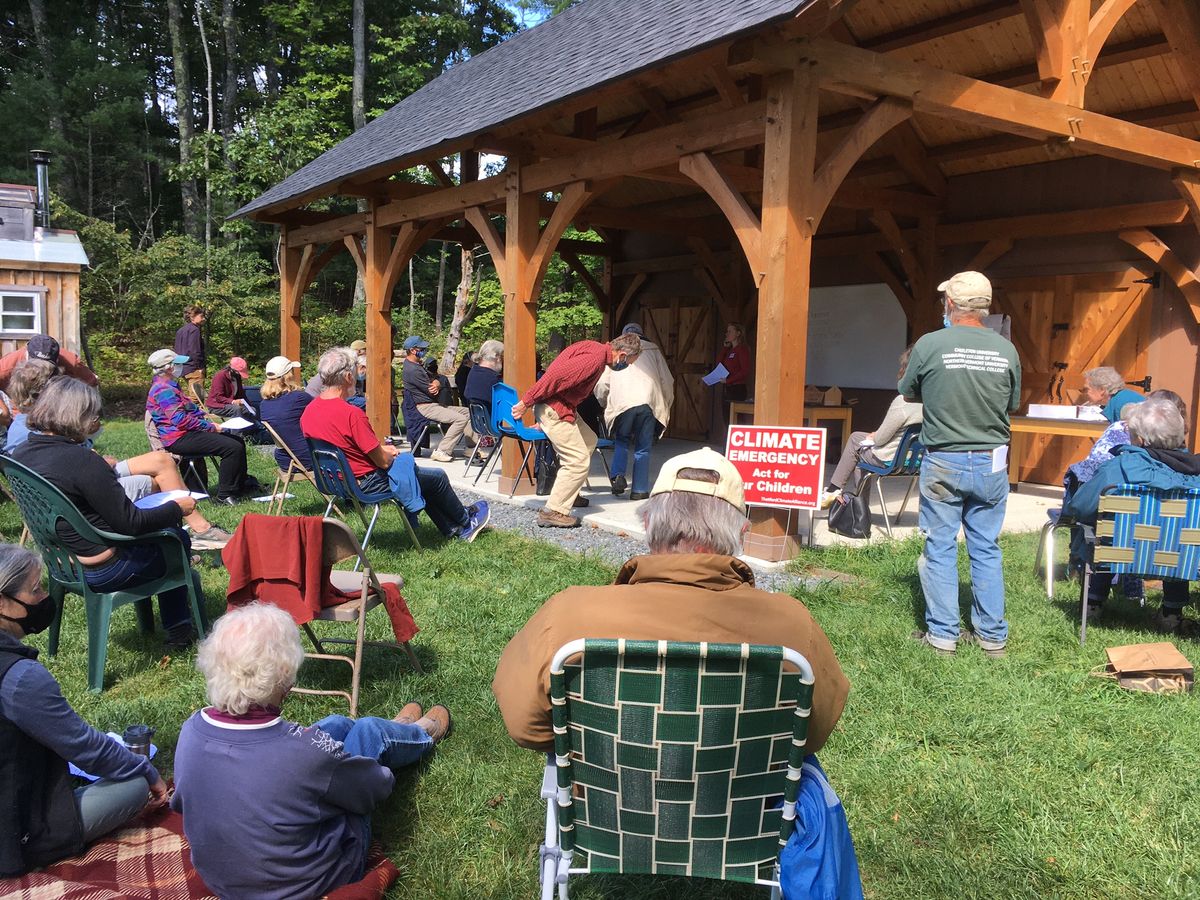Local residents weigh in on state climate policy
People are asking the state to consider nine things.

On Saturday morning, 53 people gathered at Thetford Academy’s outdoor classroom to consider Vermont’s response to the mounting climate crisis. They came from Thetford and Strafford, mostly, but also from at least four neighboring towns. By the end of the meeting, many of them had signed up to take concrete steps to influence climate policy toward fairness, transparency, honesty, and effectiveness.
Strafford resident Vanessa Rule, assisted by Thetford resident Scot Zens, gave an introduction to Vermont’s 2020 Global Warming Solutions Act (GWSA), which was sponsored by Thetford Rep. Tim Briglin. The law, which was passed over Gov. Scott’s veto, replaced Vermont’s previously unenforceable goals with requirements for greenhouse gas emission reductions by 2025, 2030, and 2050. The Vermont Climate Council was created as the first step of implementing the new law, with the development of a Climate Action Plan due on December 1 of this year. The plan may guide legislation in the next session and will be used to develop concrete rules by State agencies no later than December 1, 2022.
Scot Zens reviewed the makeup of the Vermont Climate Council, one third of whom are Scott administration appointees, the rest having been appointed by the legislature. He also described the five subcommittees that are developing recommendations for various aspects of the Climate Action Plan. The subcommittees are made up of VCC members and others who the VCC appointed for their expertise in relevant fields.
Vanessa Rule elaborated that some of the more influential members of the Climate Council represent traditional energy utilities, either directly or indirectly, or are State officials who appear to be especially deferential to utilities. Although diversity of opinion does exist on the council, the members who do not support “business as usual” have been less outspoken so far. Those members, she said, need to hear support from the public in the form of comments requesting fairness, transparency, and honesty.
While the Climate Action Plan is developing rapidly, opportunities for public input are limited. The state has hired consultants to take comments at a small number of in-person meetings and at virtual meetings accessible to those with adequate technology. Several people noted that most of the locations of the in-person listening sessions are quite distant from where most Vermonters live.
• Tuesday, September 21, 5-7pm: Elmore State Park Pavilion, Elmore
• Wednesday, September 22, 5-7pm: Emerald Lake State Park Pavilion, East Dorset
• Thursday, September 23, 5-7pm: Lakeside Park Pavilion, Island Pond
• Sunday, September 26, 3-5pm: Airport Park Pavilion, Colchester
• Thursday, September 30, 6-7:30pm: Virtual event via Zoom
• Tuesday, October 5, 6-7:30pm: Virtual event via Zoom for BIPOC communitiee
• Wednesday, October 6, 6-7:30pm: Virtual event via Zoom
Find details and updates at the VCC home page.
Nonetheless, many people at Saturday’s meeting indicated their intention to attend one of the in-person or virtual sessions to make comments about what they want to see, and not see, included in the Climate Action Plan. People were also encouraged to file written comments at the Vermont Climate Council public input portal.
Common themes expressed at Saturday’s meeting included the routine exclusion from policymaking of Vermont’s young people and the economically and culturally disadvantaged segments of Vermont’s population, who will suffer the most from climate chaos. There was also concern about the lack of transparency and the historical and ongoing deception in the official accounting of Vermont’s greenhouse gas emissions. More than one person noted that inaccurate information is bound to lead to ineffective policies, potentially doing more harm than good.
There was considerable agreement, also, about necessary elements of an updated climate policy. Those include a massive, adequately funded statewide program to weatherize Vermont’s housing stock, with priority given to low-income residents. Another is the need for a rapid transition to electrification of Vermont’s transportation sector, with targeted incentives to make it affordable to all Vermonters. A third is a reversal of the current trend that discourages community-owned solar arrays and erodes residential net-metering credits.
Vanessa Rule went on to speak about the Just Transition campaign in support of a “People’s Climate Action Plan” that was launched by 350VT this summer. The campaign endorses nine elements, which the Climate Council is asked to include. For example, the first two are for a climate plan that
• Is aligned with the Just Transition principles developed by the Council’s Just Transition Subcommittee.
• Counts all greenhouse gas emissions accurately to ensure our actions are impactful and proportional to the scale of the crisis (including out of state emissions and methane from Hydro-Quebec).
Activists in towns around the state have been collecting Vermonters’ signatures on “postcards” bearing the nine requests. Susan Hodges announced at the meeting on Saturday that she and other Strafford residents have collected over 170 signed postcards. 350VT hopes to deliver 6500 cards to the Climate Council this fall. By the end of Saturday’s meeting, attendees had taken about 400 cards for signatures of their neighbors.
For more information or to get postcards contact Vanessa Rule at vanessa@350vt.org.
